Are the Feds Going to Lower Interest Rates Again?
The Fed's QE is officially over. As we noted in our contempo Daily Market place Commentary:
"The Fed will officially end the latest round of QE on Midweek. The schedule below shows that on March 9th, the Fed will make its final QE purchase of about $4 billion of shorter-term Treasury notes. Since March 2020, the Fed'due south balance sheet has risen past nearly $5 trillion due to QE. The Fed will however purchase bonds but simply to offset maturing bonds and continue its residuum canvas stable. Given the new monetary policy government, we must focus across the Russian conflict. This entails amend risk management every bit a central source of liquidity is now officially ending."
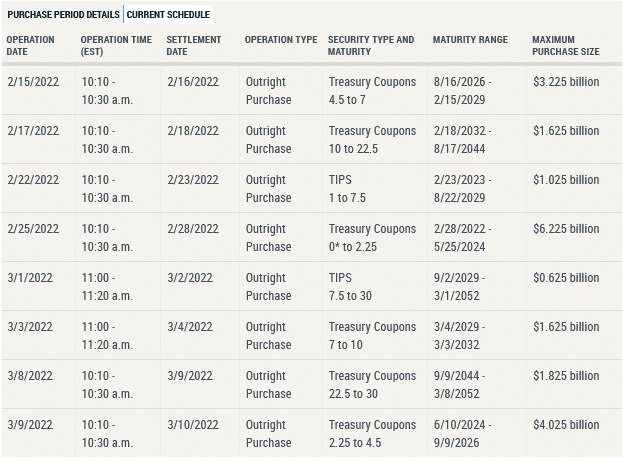
QE Schedule
Why is this important?
As we discussed in the Fed'south QE has been the primary driver of nugget prices since the financial crisis.
The primary bullish argument for owning stocks over the concluding decade is that low-interest rates [the Fed'southward QE programs] support high valuations.
However, if depression rates and the Fed'southward QE programs drive nugget prices higher, then the reversal of those policies can NOT as well be supportive.
With valuations still high by all historical measures, removing accommodative policy will claiming those justifications for overpaying for avails.
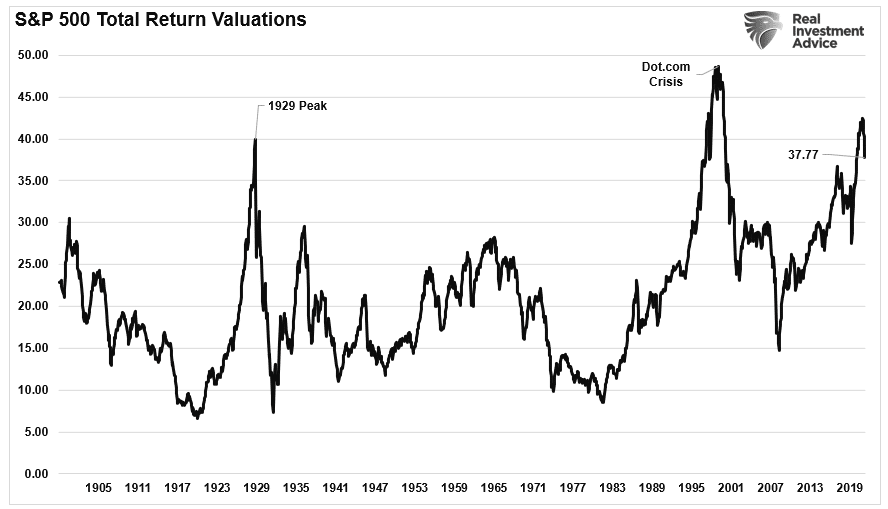
SP500-Total Return Valuations
Fed'south QE Boosted Nugget Prices And Crushed Savers
Minneapolis Fed President Neel Kashkari in one case stated that the Fed'due south QE program has no touch on on the financial markets.
"QE conspiracists can say this is all about balance canvas growth. Someone explain how swapping one short-term run a risk-gratis instrument (reserves) for another brusque-term take chances-free instrument (t-bills) leads to disinterestedness repricing. I don't see it."
While he may be "technically right," equally noted, there is aplenty evidence of a direct bear on on financial markets. As discussed in
"Given the high correlation between the financial markets and the Federal Reserve interventions, there is credence to Minsky's theory. With an R-Square of nearly 85%, the Fed is impacting fiscal markets."
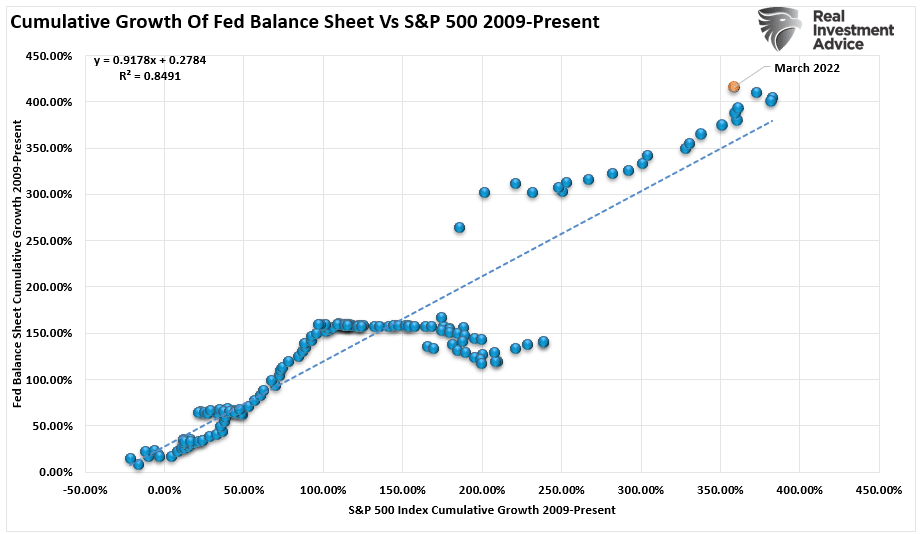
Fed Residual Sheet vs SP500-Correlation
Given such a loftier correlation to asset prices, logic would state that any contraction of the Fed'due south residuum sheet will negatively impact markets. As shown below, such has repeatedly been the case each time QE programs accept ended.
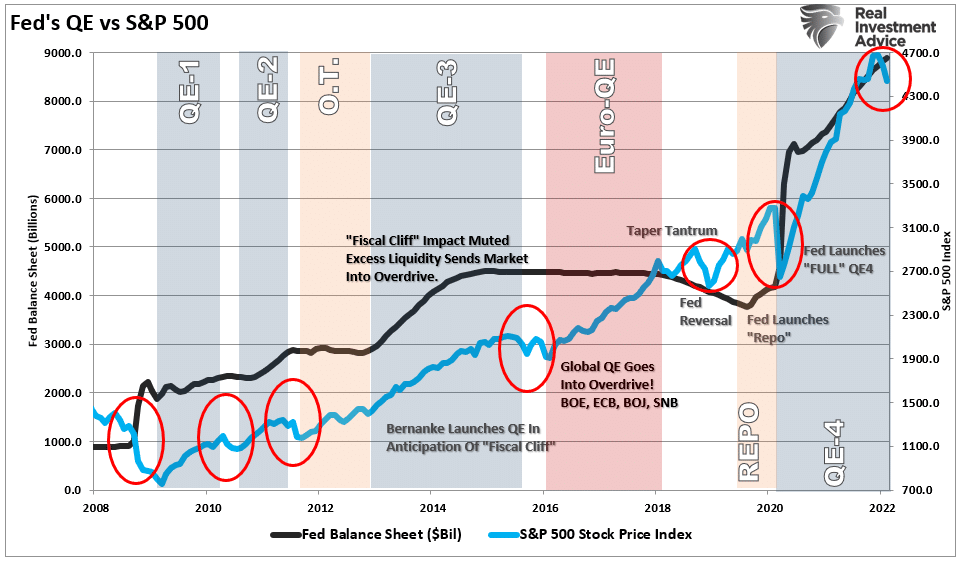
Feds Rest Sheet vs SP500
For the last 12-years, the investing mantra was elementary "Don't fight the Fed." As long as the Fed pushed liquidity into the financial arrangement, there was no reason not to own equities.
The trouble lies directly with the Fed's monetary policy decisions implemented since the plow of the century, and notably, the Financial Crunch. Every bit each bailout of the financial system occurred, yields savage along with inflationary pressures and economic growth.
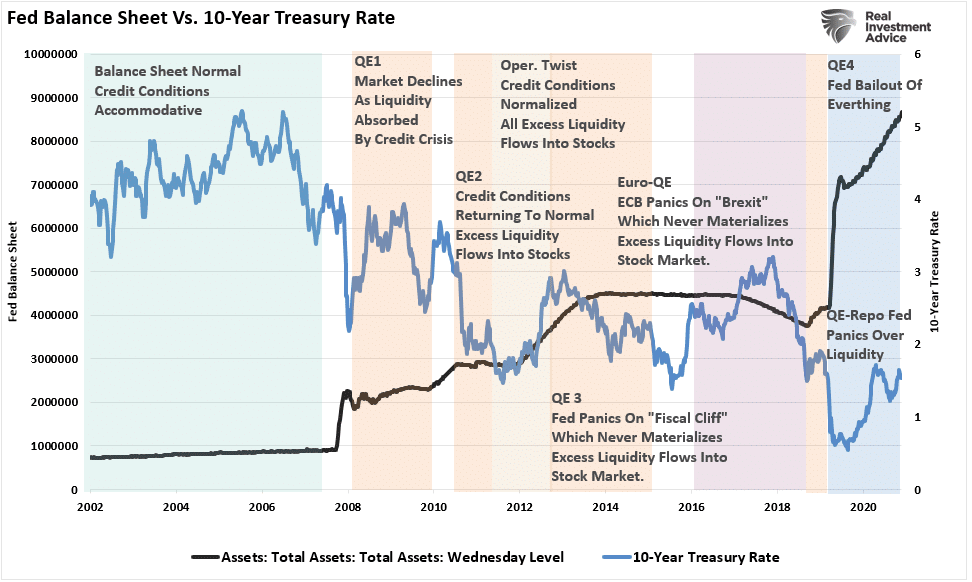
Fed Residual Canvass vs Annotized 10-Year Rate
The Fed'due south monetary policy forced "savers" into "chance" assets and out of cash. Such, the Fed believed, would increase confidence and back up economic growth. Even so, the opposite occurred as economic growth rates, inflation, and interest rates fell. Unfortunately, savers were the victims.
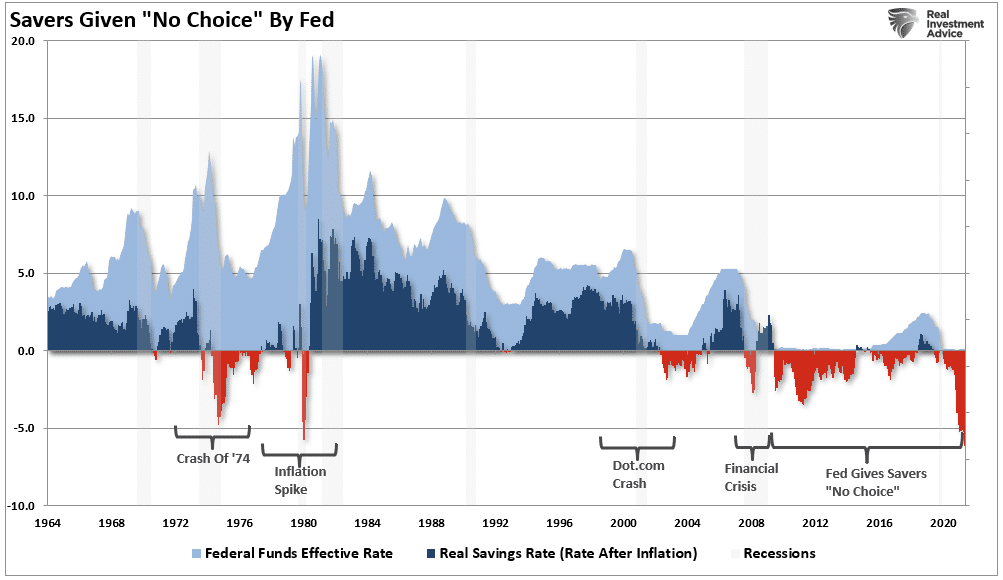
Fed Existent Savings Rate
Since 2009, the Fed'south QE programs boosted nugget prices but crushed savers. The reversal of those policies negatively impacted investors.
But, until now, the Fed never faced .
High Aggrandizement Is The Divergence
Since Paul Volker, the Fed faces a tough choice for the first time. With the Fed's QE program concluded, they now want to outset hiking rates to combat the highest inflation levels since the 70s. However, aggrandizement is already tightening monetary policy very rapidly. To wit:
"The following chart from Goldman Sachs compiles the most widely used fiscal conditions indexes. Every bit shown, financial weather are at the tightest in two years. Such is driven by soaring energy prices, sliding stocks, and the market fallout from the Ukraine-Russia conflict. Excluding March 2020, the last time financial conditions were this tight, the Fed Funds charge per unit was nearly to hit the past wheel loftier of 2.l%." – Zerohedge
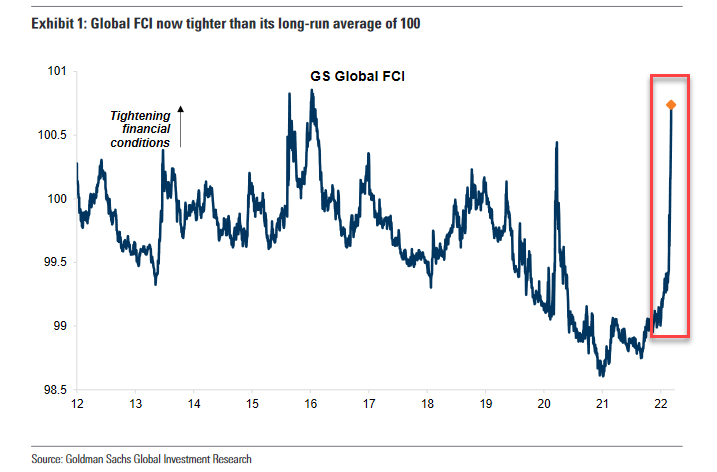
Global Financial Tightening
The trouble for the Fed is they are currently even so at ZERO. Therefore, with the Fed'south QE removed, any hikes to interest rates volition exacerbate substantially tighter monetary policy.
The surge in inflation was already problematic for consumers before prices surged to $120/bbl. Furthermore, with prices skyrocketing, higher costs of living for consumers are likewise extracting budgetary liquidity from the economy. Such leaves the Fed very little room to hike rates earlier the economy slips into a recession.
The nearly significant risk to the Federal Reserve is "financial stability." Such is particularly the case with the entirety of the financial ecosystem now more levered than always.

Margin Debt As Percent Of DPI
The Fed's "financial stability stress tests" suggest "banks are well-capitalized" and can withstand a downturn in the economy and the markets. However, each fourth dimension "financial stability" arises, the Fed rushes to bail out the banks once once again.
This time likely won't be any different with record leverage and credit in the economy.
The Fed's QE Is Dead. Long Alive The Fed's QE
"The Federal Reserve has done more in the by 25 years than its founding legislators e'er conceived. With that in mind, one wonders what the finish game is, especially in calorie-free of two facts.
- First, the inclination of monetary authorities the earth over is toward lower and lower thresholds for intervention.
- Second, fiscal and monetary policies have a way of all of a sudden finding limits when the revenue enhancement-payers are on the receiving end.
If there is a component of the growing disposition for risk inspired past the idea that the Fed will dive in to salvage retail investors from failed ETFs, collapsed SPAC prices, a wave of microcap stock delistings, or any other consequence of their understandable just reluctant march up the chance curve, it is ill-brash.
Any lasting solution is far more likely to come up from markets themselves." – American Institute
I would carefully consider the last sentence.
While financial underpinnings seem stable currently, they historically tend to become "unstable" quickly. Such is the example when the Fed hikes rates to the point it creates an effect concerning leverage.

Margin Debt Pct DPI vs Fed Funds
While the Fed is likely to hike rates and reduce monetary adaptation in their quest to battle inflation, that fight will end speedily when "instability" arises.
How would such a dramatic turn occur?
- At 20% margin calls will begin to rise put pressure on asset and high-yield credit markets.
- When the market declines 25%, yield curves will beast fully inverted as economical growth crashes.
- At xxx%, corporations will exist laying off workers and moving to protect profitability.
I suspect, as noted higher up that somewhere between a twenty-30% reject, we will see the Fed render their focus to "market stability."
Have no fear; QE will be dorsum.
Source: https://www.investing.com/analysis/feds-quantitive-easing-is-over-until-it-comes-back-200619934
0 Response to "Are the Feds Going to Lower Interest Rates Again?"
Post a Comment